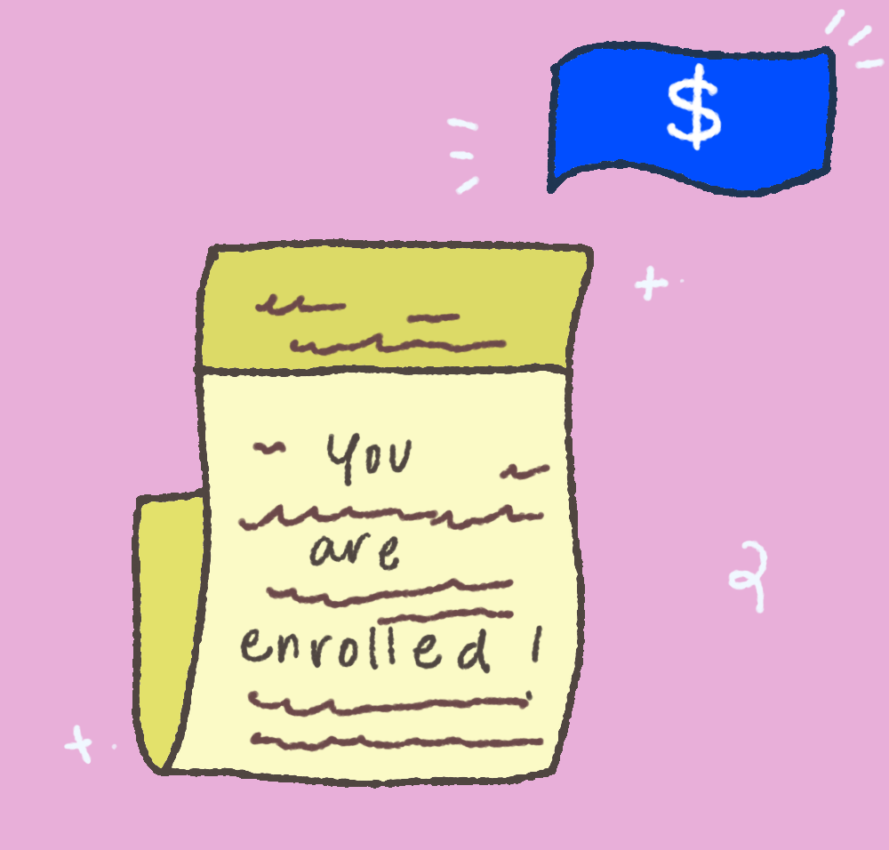USask now charging $10 (plus tax) for confirmation of enrollment letters through new MyCreds system

In true post-secondary penny-pinching fashion (though in this economy it’s starting to feel more like “quarter-pinching”) USask has decided that requesting your confirmation of enrolment forms should cost you ten extra dollars (plus tax).
On Dec 7, 2022, during one of the most stressful times for undergraduate students — finals — the university sent out an email newsletter shedding light on a newly adopted program, MyCreds. USask students will be required to use this program to access their confirmation of enrolment letters going forward. Buried in the middle of the newsletter — without a spot of notice in the title and just a short header — it states that “[through the MyCreds program] confirmations of enrolment and graduation costs $10 (plus tax), which gives you 120 days to share the document an unlimited number of times in that time period.”
The new MyCreds system replaces the old means of accessing confirmation of enrollment letters which was previously accessible free of charge through PAWS.
According to USask’s Student and Academic Services Knowledge Base web page under the section header, “Why did the university change to use MyCreds?”, reasoning for the system change includes: making proof of enrollment password protected, authenticated, accessible 24/7, easier to manage, faster for students, institutions and outside-organizations alike to use, and more sustainable “in reducing the use of paper products”.
Additionally, the webpage also states that the university adopted the MyCreds system because it provides Canadian institutions with “what other areas, like the US, Europe, China, and Australia, have long had—a means to exchange official documents electronically between post-secondary institutions and with external institutions, organizations, companies and governments, domestically and internationally.”
Both of these reasons for adoption of MyCreds were confirmed by Russell Isinger, the interim vice-provost of teaching, learning and student experience, following the Sheaf’s request for comment.
“Before MyCreds, Canadian post-secondary universities and colleges were responsible for developing their own system to share official documents that were verifiably authentic. This was a costly and inefficient approach,” Isinger said in an email response to the Sheaf. “In launching the national network MyCreds, Canadian universities and colleges have joined together to streamline the process of sharing documents. This is a best-practice process that is common in other countries.”
Jason Main, a second year math student, doesn’t view these additional services, nor the enhanced “efficiency” of the MyCreds system, as worth the cost. “I have to send my confirmation of enrollment to a lot of people,” he said. “[the MyCreds system] feels like another way to increase student fees.”
“In the past you could download the enrollment PDF for free, you could send it to whoever you wanted to for free; now you have to pay to do all that. It seems like efficiency is the institution’s problem, but I think there are other ways of solving it than requiring students to pay for it.”
Daniel Currie, another USask undergraduate student who completed a math degree last winter and is currently pursuing a second degree in Physics, discovered that the MyCreds company doesn’t even dictate how much USask is supposed to charge for its services.
“USask determines the costs associated with viewing documents. MyCreds does not determine this,” Currie said. “Realistically, USask is not paying $1.00 per student per request to be a part of MyCreds, let alone $10.00 or $20.00. If they are paying this much, they are demonstrating irresponsible spending habits and should consider taking a personal finance course.”
Currie also adds that “this is yet another organization that has access to — and most critically, control over — some of my most personal details. I was never warned that I would now have to go through this whole other system. And now I’m forced to abide by this system.”
On the My Records channel on PAWS, it reads that “the transcript order process through MyCreds began in early October 2022.” Students were given no warning that there would be an additional cost added to their already pricey tuition and living expenses. The newsletter from Oct 5 never mentioned a change to the MyCreds system, nor did any of the three newsletters between Oct 5 and Dec 7.
Isinger’s response to the $10 price tag set on requesting confirmation of enrollment letters touched on both the institutional operating costs of the program, as well as offered insight into how it may be adapted in the future.
“The $10 fee … is comparable to what other universities are charging. About two thirds of the cost to share documents through MyCreds covers the cost of operating MyCreds nationally, and the other one third goes to the university to cover internal administrative costs associated with MyCreds,” he replied. “The price we have set for each share credit will be reviewed after the first year of operation. Any revisions to the $10 fee will go through USask’s fee approval committee, which includes staff, faculty and student leaders.”
Let’s acknowledge the variety of institutions and companies that offer university students a student discount on their services: electronics (Microsoft, Dell, Staples, Apple, etc.), banking (Scotiabank, CIBC, TD, RBC, etc.), streaming (Spotify, Amazon Prime, etc.), amongst many others. Many of these companies have one thing in common: the necessity of proof of enrollment. The mere fact that these companies are willing to offer a student discount means that they acknowledge the financial stress that students undergo while studying at a post-secondary school. It feels a bit ironic that the university cannot provide that same discount to its own students. All in all, while the MyCreds system has its benefits, this extra $10 (plus tax) that students must pay makes it seem like the university wanted to find yet another service for which they can charge students to fill a hole in their budget.